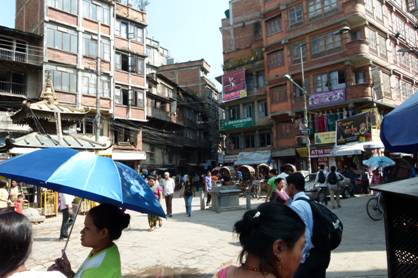Nepal Earthquake
The World is shocked by the growing death toll, that has now passed 5,000 as a result of the recent earthquake in Nepal.
The epicentre was close to Pokhara the country's second largest city with a population just over a quarter of a million. Just how many of the deaths occurred there is not yet clear.
Pokhara (Click Here for an online image) in a major centre for trekking with three of the World's top ten highest mountains within walking distance. The quake caused avalanches in the nearby Himalayas and trekkers were killed as a result, including one Australian further away near Everest.
Much of Nepal's building is substandard. The capital, Kathmandu, has a large ramshackle 'old town' area that is very vulnerable, in addition to modern areas with more substantial structures.
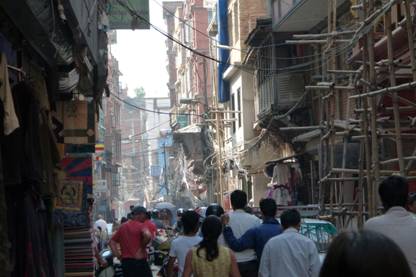 |
 |
Kathmandu's old town area contrasts with a modern shopping mall
But earthquakes have a habit of focussing their force according to underlying geology so that adjoining streets or buildings can be more or less hit.
Kathmandu is the largest city and the location of the International Airport and the home of the expatriate population so it's the place of devastation that we are seeing most frequently on our evening news. It's also the location of many of the temples that have been demolished.
Like many Australian and European tourists we visited Kathmandu and several of the the surrounding towns in October 2012. So the places we are seeing on our evening television news are familiar.
The dead are gone and immediate concern must now be for the survivors, particularly some nine or ten thousand injured trying to get help in overcrowded hospitals.
Many survivors are living under canvas until buildings can be made safe, repaired and/or rebuilt. This is a balmy time of year except for the rain. The immediate concern is, as always after such a disaster, the provision of clean water and preventing the outbreak of an epidemic - particularly of measles or cholera.
When we were in Kathmandu we visited the Ghats where the dead are cremated on the banks of the holy Bagmati River, a tributary of the Ganges. Without having seen it one might imagine that the River, with alleged healing powers, would be a convenient source of water. But it is heavily polluted with rubbish and the addition of partially burnt human flesh makes drinking its water an even more risky proposition.
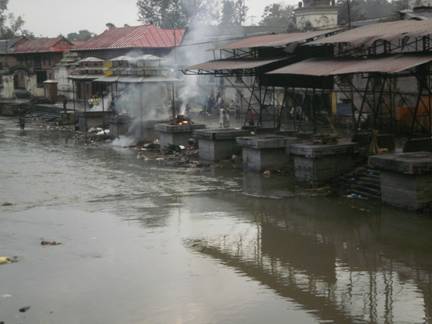
Part of the cremation Ghats
The Ghats are reported to be working overtime but cremating several thousand in the traditional manner is clearly a task well beyond their capacity. There must be mass graves or cremations.
This is a human tragedy on more than one level, particularly for the faithful.
The loss of heritage temples and landmarks, essential to tourism as well as to indigenous religious practice, is also distressing.
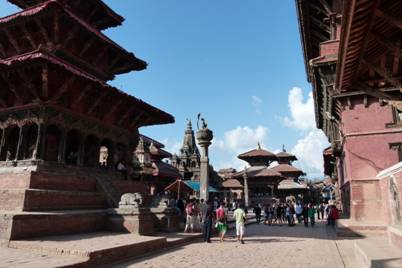 |
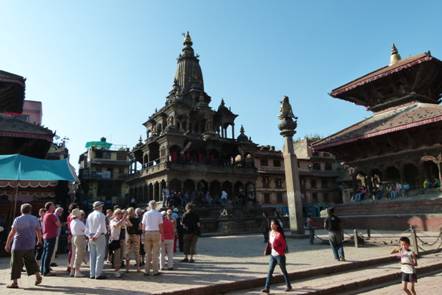 |
Temples equals Tourists
The most numerous of these structures are in Kathmandu itself and two nearby towns: Lalitpur and Bhaktapur. All three are within the destruction zone, particularly as a series of aftershocks have been moving along the fault-line towards Kathmandu.
The earthquake will have ongoing economic consequences, not the least being ongoing paranoia about possible reoccurrences.
The principal source of Nepal's foreign income is remittances, from expatriates and soldiers serving in foreign armies, particularly the fearsome Ghurkhas, followed by foreign development aid. This aid should not be reduced and may even increase.
As in the case of other mendicant societies, dependence induces a sense of powerlessness and there have already been demonstrations demanding more 'government' assistance despite the Government's resources being obviously inadequate. This seems foreign to cultures in which people feel personally responsible so that the first resort in a disaster such as a flood, bushfire or cyclone is to local volunteers and community cooperation and where government is seen as a high level organiser, not a primary source of human or material resources. Instead of demonstrating why aren't these young men out there cleaning-up, helping the needy and repairing or rebuilding?
Tourism is the next most important source of foreign income, ahead of manufacturing (mainly carpets and clothes) and agricultural exports. These domestically generated earnings are likely to be affected in the short to medium term.
While some more modern hotels are probably able to operate as before, some of those in the backpacker areas have reportedly been demolished.
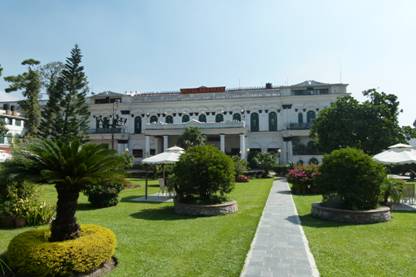 |
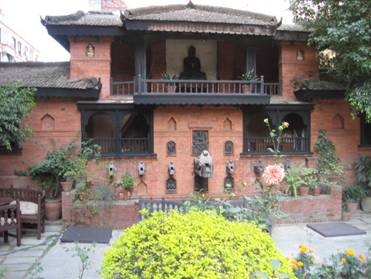 |
An up-market and not so up-market hotel in Kathmandu
New hotels will need to be built, hopefully to improved building standards, before tourism can fully recover.
Fortunately the great majority of Nepalese Hindu temples, pagodas and are quite primitive structures that can no doubt, be rebuilt relatively quickly. Several dome-like Buddhist stupa are more substantial but probably more resilient.
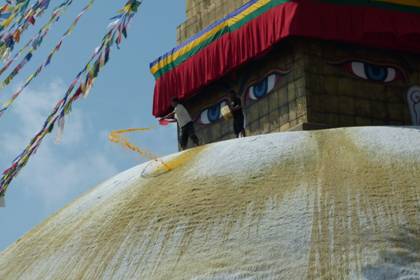
Maybe the top structure is vulnerable
Given their intrinsic instability, many of these temples were seriously damaged in the last major earthquake and some have already been rebuilt several times.
But the possible destruction of singular artefacts such as statues and images that may have been within the fallen buildings is always a worry.
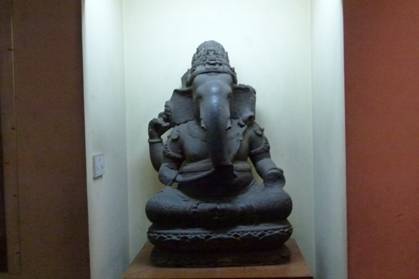 |
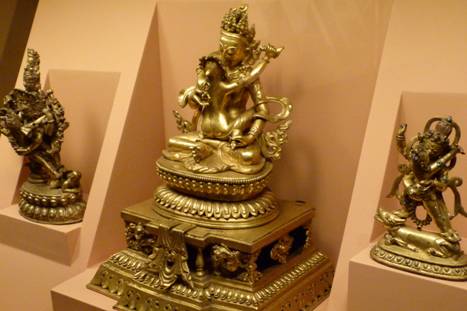 |
Hopefully the Museum was secure
Nepal is one of the most earthquake prone regions in the world and there have been a number of past quakes, similar in scale (1810, 1833, 1866 and 1934) plus hundreds of less serious events. There is evidence of earlier major earthquakes when the kingdom was so isolated that the wider world did not receive news of them.
Unfortunately Nepal was subject to rapid population growth in the twentieth century, resulting in a large, poorly educated and young population and one of the lowest per capita incomes in the world. Many people live in overcrowded substandard accommodation.
Recently the aid agencies like GeoHazards International (GHI) have been warning that a major earthquake event was imminent. Unfortunately, the ability of the Government and people of Nepal to respond to these warnings has been limited. Some have no doubt fallen back upon their beliefs in religious inevitability and the fruitlessness of efforts to avoid one's fate or Kama or their scepticism about the predictions of modern science.
Mankind's religious buildings do seem to be particularly vulnerable to earthquakes. I was struck by the disproportionate damage done to Newcastle's (NSW) churches in the earthquake there in 1989 that I experienced first hand. Elsewhere, the impact on Lisbon's churches in the earthquake, fire and tsunami of 1755 was so great that the validity of the Church and religion itself was called into doubt facilitating the introduction of secular government in Portugal.
To read more about our 2012 visit to Nepal click here... Read More...
To see more photographs click here ... See More...

